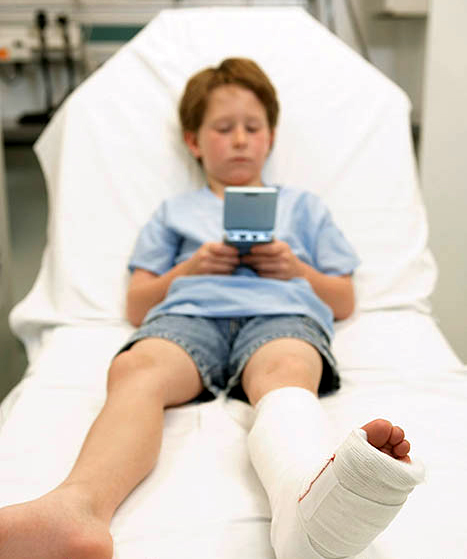Children’s TV Screen Time: Consequences, Limits, Interventions – Part 1
The time that children spend in front of a screen of all kinds has exploded to the point of danger in both physical development and disease. Average children’s TV screen time has been shown to be nearly THREE TIMES (300%) greater than the level shown to cause morbidity – and it’s pretty much world-wide.
A recent article in the Archives of Diseases in Children points out that in Britain a 10-year-old child regularly views an average of five different screens at home. Not restricted to just the family television, most have their private TV in their room as well as game consoles, smartphones with games, internet and video, family computer AND a laptop or tablet computer!
All of us have seen kids using two or more screens at once – TV and texting! Even in the youngest of American children, one out of three have a TV in their own room and half (50%) watch TV or DVDs for 2 hours or more every day.
What’s The Issue?
Since my own childhood I’ve been aware that nearly all the angst and arguments adults seemed to have had about TV revolved around it’s content. It’s as if the quantity was merely a given. Only recently has the morbidity of SCREEN TIME (ST) even pushed the “quality” argument to the other side of the coin for parents in the industrialized world.
Children’s Screen Viewing Time
7 years-old — 61,320 hours
18 years-old — 157,680 hours
80 years-old — 700,800 hours
Truly, watching screen media is obviously the main pastime of children. Through childhood kids spend more time watching TV than they spend in school. Incredibly, by the age of seven a child has spent ONE FULL YEAR OF 24 HOUR DAYS watching TV, computer games, DVDs and internet. A European child by age 18 will have spent 3 years of 24-hour days glued to the screen and by 80 years of age a 17.6 mind-numbing, eye-glazing, body-rotting, screen-viewing, 24-hour-a-day, years. Which is 52.8 years of 8-hour work-days!
Even taking content or educational value out of the picture entirely, the sheer enormity of the activity should leave no one the least bit surprised to find that we are now finding actual diseases and even mortality related to it. Even more concerning is that watching a screen seems to have it’s own set of risks/problems OVER AND ABOVE those of “merely” being sedentary, as I’m going to describe.
Current Children’s TV “Dosage” Level
Trying to get a handle on any medical conditions related to screen time one has to perform the most difficult and time consuming kind of research. One has to begin with inventing methods to accurately measure a child’s screen time both in and out of the home. Then there must be the ability to follow the same children medically for an extended amount of time – decades even.
 Fortunately, there are scientists doing just that and there are some of the very first good studies beginning to report results. What are some of the beginning “dosages” children are at currently? Well, for one, British adolescents view screens 6.1 hours a day INSIDE the home (the study excluded all outside the home viewing). A similar figure for Canadian children is 7.8 h/day and for American, 7.5 h/day. Do the math, that’s fifty-five percent of their waking lives!
Fortunately, there are scientists doing just that and there are some of the very first good studies beginning to report results. What are some of the beginning “dosages” children are at currently? Well, for one, British adolescents view screens 6.1 hours a day INSIDE the home (the study excluded all outside the home viewing). A similar figure for Canadian children is 7.8 h/day and for American, 7.5 h/day. Do the math, that’s fifty-five percent of their waking lives!
And currently, the studies show, the figures are still on their way UP. A European Union study of thousands of lower socio-economic status children revealed that generally parents had no formal rules about TV and they can watch TV all day long whenever they want.
So, I’m in a real quandary here about how to present the numerous pieces of information and issues that are being revealed in a way that doesn’t overwhelm or boor you. Perhaps, in a blog posting like this, I can only summarize the nuggets of proven knowledge from good studies which have risen beyond conjecture.
One of the things we DO know now is that children’s screen time is at the level of proportion like having an alligator loose in your swimming pool. It’s not merely about content any more – it’s a true medical issue with real morbidity and mortality and we have shown it to have a dose-response relationship.
Mortality and Morbidity Of Children’s TV?
If you, or any responsible parent, had decided to take the time and effort to ferret out the newly discovered research about TV screen time and diseases of children you would understand why this article is starting to become a bit, well, preachy. Articles and findings are becoming so numerous that they are at least in the same league as that of global warming and the ozone layer research.
Every 1 hour/day increase in television viewing resulted in a 6% increased risk for fatal or non-fatal CVD as well as an 8% increased risk for coronary heart disease (CHD).”
What I mean by that is: more numbers than we can easily count of, well designed, prospective, long term cohort studies continually find highly significant, dose-response association between children’s screen time and the risk of type 2 diabetes, cardiovascular disease and even all-cause mortality clear into adulthood.
Huh? All cause MORTALITY? Yes. That’s what they found! Take hundreds, if not thousands, of kids. Meticulously measure actual screen time in their daily lives. Compulsively follow their medical histories for decades and surprisingly discover that more of your high screen time kids are dead, for all reasons, than your low screen time kids – and it’s way beyond statistical chance.
 They, the high screen time kids, also are taking more insulin for their diabetes and have had bypass surgery for their cardiovascular disease (CVD). And what I mean by “statistical significance” is that they are way more sick than chance, even when you account for age, gender, smoking and other things.
They, the high screen time kids, also are taking more insulin for their diabetes and have had bypass surgery for their cardiovascular disease (CVD). And what I mean by “statistical significance” is that they are way more sick than chance, even when you account for age, gender, smoking and other things.
One good study actually quantified that “every 1 hour/day increase in television viewing resulted in a 6% increased risk for fatal or non-fatal CVD as well as an 8% increased risk for coronary heart disease (CHD).” And all this was completely independent of gender, age, education, smoking, alcohol, medication, diabetes status, CVD family history, sleep duration and physical activity energy expenditure.
You don’t believe it yet? Ok, completely different studies by completely different scientists using completely different kids found that grouping the kids into 4 hours/day or more of recreational screen time and less than 2 hrs/day produced a 48% increased risk for all-cause mortality and a 125% increased hazard for CVD events!”
Nearly everywhere they look they find a terribly distressing correlation. There seem to be smoking guns all over the place! In both children and adults, screen time shows a literal dose-response, negative relation with a whole host of biomarkers for CVD, type 2 diabetes, metabolic syndrome, LDL/HDL/Total cholestrerol, triglycerides, fibrinogen, systolic/diastolic blood pressure and C-reactive protein.
“…even active kids who have increased screen time are likely destined for bad health”
Some of that is doctor talk; but, trust me, it’s not good. In yet another study, adolescent boys with greater than 2 hours/day screen time were more than twice as likely to have abnormal levels of insulin and insulin resistance – pre-diabetes, even though it’s not yet shown in their bodies.
And still further, thirteen to eighteen-year-olds in five Spanish cities who were found to be watching more than 3 hours of TV per day have significantly worse levels of HDL-cholesterol, glucose and apolipoprotein A1 in addition to their overall worse CVD risk scores.
And, even yet we still are not done. One of the final straws on this camel’s back is that: even though you might think that all the bad things related to screen time are related to just becoming a couch potato – they’re not. Some good studies, that I’ll save for part two, show that even active kids who have increased screen time are likely destined for bad health.
Next, we’ll talk about why even active kids may be suffering when they get too much screen time and some basic interventions and parental rules which can prevent it from happening.
[Reference: Arch Dis Child. 2012;97(11):935-942. (Brighton UK Psychologist Aric Sigman)]
2 Posts in Children's TV (tvtime) Series
- TV Injuries on the Rise in Children – 15 Nov 2013
- Part 1 - TV time – 4 May 2013

